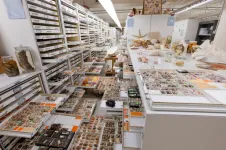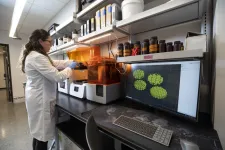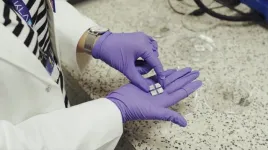(Press-News.org)
The University of Southern California (USC) is collaborating with Auransa Inc., on a phase 1 clinical trial to evaluate a new kind of treatment for cancers of the liver and solid tumors with liver dominant disease. The drug, known as AU409, was developed by Auransa, a clinical stage drug development company focused on identifying novel drug candidates for oncology, inflammatory diseases and diseases of the central nervous system. In preclinical trials, AU409, has been shown to work in a unique fashion by limiting the cancer cell’s ability to translate the message from various genes that are essential for the cancer cell’s ability to survive and multiply. In other words, AU409 interrupts the cancer cell’s machinery, preventing it from using DNA code to produce proteins that it needs to grow.
Liver cancer is estimated to be the third most common cause of cancer-related deaths worldwide, and hepatocellular carcinoma (HCC) accounts for about 80% of all liver cancers. Despite major improvements in treatment, patients with advanced HCC continue to have limited median overall survival due to primary or secondary resistance to existing therapies. While chronic hepatitis B and C infections continue to be important risk factors for liver cancer, the rising prevalence of obesity, non-alcoholic steatohepatitis (NASH), and alcohol consumption are becoming the dominant risk factors for liver cancer in the United States as well as the rest of the world.
The trial will involve patients from the USC Norris Comprehensive Cancer Center with advanced primary liver cancers or with advanced solid tumors with liver predominant metastatic disease. Its principal investigator is Dr. Anthony El-Khoueiry, a leading expert in early drug development for solid tumors, particularly gastrointestinal cancers. Dr. El-Khoueiry is the Director of the phase I program and Associate Director for Clinical Research at the USC Norris cancer center and Associate Professor of Clinical Medicine at the Keck School of Medicine of USC.
“We are excited at the potential impact our collaboration with Auransa can have for patients with solid tumors with liver predominant disease, in particular patients with hepatocellular cancer and cholangiocarcinoma. AU409 has a unique mechanism of action that impacts gene expression in the tumor and may represent a novel therapeutic approach for these tumors with high unmet need.” said Dr. El-Khoueiry.
“The collaboration with the USC Norris Comprehensive Cancer Center is an important first step in the clinical development of AU409 which is a new chemical entity with a unique mechanism of action. We plan to work closely with the team at USC to advance this very differentiated potential new drug for patients with liver cancers, specifically hepatocellular carcinoma (HCC), who may not respond to the currently available drugs.” said Pek Lum, Ph.D., co-founder and chief executive officer of Auransa.
“Dr. El-Khoueiry’s clinical trial experience spanning first-in-human, phase 2 and phase 3 trials, together with his interest in liver cancer, makes him the perfect lead of the AU409 clinical trial.” said Andrew Protter, Ph.D., Chief Scientific Officer of Auransa.
Auransa and USC are also collaborating on a broader approach to bring novel and much needed therapeutics to cancer patients, leveraging both Auransa’s proprietary artificial intelligence (AI) drug discovery platform to identify novel disease mechanisms and capabilities from the Rosalie and Harold Rae Brown Center for Cancer Drug Development at the USC Norris Comprehensive Cancer Center.
“The Brown Center for Cancer Drug Development takes an integrated academic-industry approach to achieve our mission of accelerating promising oncology therapeutics into the clinic through collaborative drug development,” said Caryn Lerman, PhD, director of USC Norris Comprehensive Cancer Center, and associate dean for cancer programs at the Keck School of Medicine at USC. “Together with Auransa, we are optimistic that we can develop new therapeutics for patients in need and further our mission.”
Disclosure: If this trial is successful, USC has the potential to receive royalty payments under the collaboration agreement with Auransa.
About University of Southern California’s Norris Comprehensive Cancer Center
The USC Norris Comprehensive Cancer Center (USC Norris), located in Los Angeles, is a major regional and national resource for cancer research, treatment, prevention, education, and community engagement. The National Cancer Institute (NCI) has designated the USC Norris Comprehensive Cancer Center as one of the nation’s 52 comprehensive cancer centers, a select group of institutions providing leadership in cancer treatment, research, prevention, and education. USC Norris has held this designation since 1973, at which time it was named as one of the first eight such centers in the country. The Rosalie and Harold Rae Brown Center for Cancer Drug Development (CCDD) at the USC Norris was launched in 2020 with a generous gift from the Rosalie and Harold Rae Brown Foundation. The CCDD employs an integrated academic-industry-focused management model to engage investigators from different disciplines, collapse gaps in expertise, resources, and funding, and ensure that programs have a high likelihood of progressing to the clinic.
END
March 23, 2023 – Washington, DC, New York, NY, and London, England – A group of natural history museums, organized by the Smithsonian National Museum of Natural History in Washington DC, the American Museum of Natural History Museum in New York City, and the Natural History Museum in London, has mapped the total collections from 73 of the world’s largest natural history museums in 28 countries. This is the first step of an ambitious effort to inventory global holdings that can help scientists and decisionmakers find solutions to urgent, wide-ranging issues such as climate ...
Metabolic pathways consist of a series of biochemical reactions in cells that convert a starting component into other products. There is growing evidence that metabolic pathways coupled with external stress factors influence the health of cells and tissues. Many human diseases, including retinal or neurodegenerative diseases, are associated with imbalances in metabolic pathways. Elisabeth Knust leads a team of researchers from the Max Planck Institute of Molecular Cell Biology and Genetics (MPI-CBG) in Dresden, Germany, who describe an essential role for one ...
The medicinal secrets of the Chilean soapbark tree have been laid bare, unlocking a future of more potent, affordable, and sustainably sought vaccines.
The evergreen species, Quillaja saponaria has, for decades, been highly prized for producing molecules called QS saponins, which are used in the food and drinks industry as foaming agents.
More recently an important new function has emerged with saponins obtained from the tree’s bark used as potent adjuvants in the production of vaccines. Adjuvants play a critical role in some vaccines, working to boost the potency of a vaccine by enhancing the host immune response.
Molecules extracted from soapbark tree are ...
A new report from the Centers for Disease Control and Prevention (CDC) shows the rates and demographics of children with autism spectrum disorder (ASD) are changing in the United States.
In the latest analysis, 1 in 36 8-year-old children (2.8%) have been identified as having ASD. This figure is higher than the previous estimate published in December 2021, which found a prevalence of 1 in 44 (2.3%) children, and considerably higher than the CDC’s first autism prevalence report published in 2007 noting a prevalence of 1 in 150 (0.7%).
Prevalence estimates also differed across the 11 data collection sites, ranging from 1 in 43 children (2.3%) in Maryland, to 1 in 22 (4.5%) ...
Using artificial intelligence, researchers have discovered how to screen for genetic mutations in cancerous brain tumors in under 90 seconds — and possibly streamline the diagnosis and treatment of gliomas, a study suggests.
A team of neurosurgeons and engineers at Michigan Medicine, in collaboration with investigators from New York University, University of California, San Francisco and others, developed an AI-based diagnostic screening system called DeepGlioma that uses rapid imaging to analyze tumor specimens taken during an operation and detect genetic mutations more rapidly.
In a study of more than 150 patients ...
ST. LOUIS – Research published in Environmental Research Letters has shown that methane emissions from urban areas are underestimated by a factor of three to four and that untreated wastewater may be a contributing factor.
The study, “Investigating high methane emissions from urban areas detected by TROPOMI and their association with untreated wastewater,” was led by Benjamin de Foy, Ph.D., professor of Earth and Atmospheric Sciences at Saint Louis University, and published online on ...
The impact of multi-storey building design considerations on embodied carbon emissions, cost, and operational energy has been revealed for the first time.
Using a computer model, researchers estimate that up to six gigatonnes of carbon could be saved by 2050 if new multi-storey buildings follow certain recommendations during the design process. All these recommendations, which could also save between 28 and 44% of annual heating and cooling costs, use technology that is currently available.
Construction and operation of buildings account for more than one-third ...
EL PASO, Texas (March 23, 2023) – The University of Texas at El Paso has joined a project led by NASA to leverage 3D-printing processes with the aim of manufacturing rechargeable batteries using lunar and Martian regolith, which is the top layer of materials that covers the surface of the moon and Mars.
“UTEP is a national leader in additive manufacturing for space applications,” said Kenith Meissner, Ph.D., dean of the UTEP College of Engineering. “I congratulate the team of UTEP researchers involved in this important work. I am confident their work will add significant value ...
MADISON – While recent studies and polls indicate the nation is in the midst of a mental health crisis, the situation in academia is even more grim: Within the high-stress, high-pressure, often socially isolated world of advanced education, graduate students experience depression and anxiety at six times the rate of the general population.
Normalizing mindfulness practices within the graduate student experience may be an answer, according to a three-year study conducted by University of Wisconsin–Madison ...
Scientists from Swansea University ‘s Institute for Innovative Materials, Processing and Numerical Technologies (IMPACT) and Japan have been awarded £1.3 million to develop a new “point of care testing” kit that can detect biomarkers for Alzheimer's Disease.
The project follows Dr Sanjiv Sharma’s ground-breaking work in this area and the development of the world’s first COVID-19 ‘smart patch’.
Compared to hypodermic single needles, a ‘smart patch’ consists of a collection of tiny needles - microneedles - created to break the skin barrier in a minimally invasive ...




